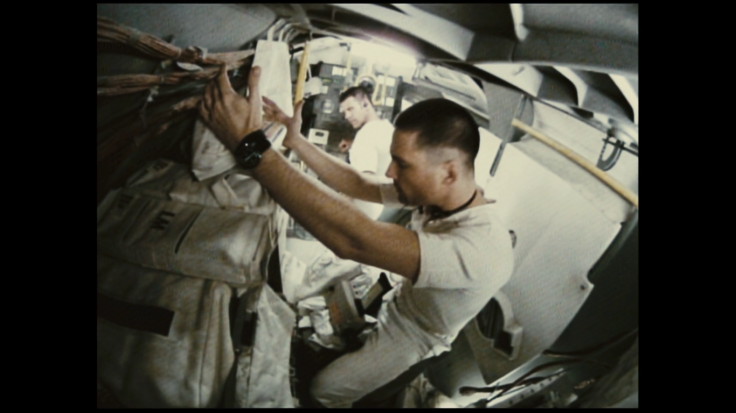In 1970 the final three Apollo flights—18, 19, and 20—were cancelled, victims of the penny-pinching Nixon administration, and their hardware was either shelved or used for the Skylab program. As a result, only twelve humans from six missions have walked on the Moon.
Or so the government would have you believe.
I’ve recently rewatched Apollo 18, a found-footage horror film that takes this premise and runs with it. While it’s obviously a B-movie, made on five million dollars, and it has no shortage of goofiness, it’s also an entertaining piece of (surprisingly well-researched) alternate space history. Spoilers ahead.

Apollo 18 is a found-footage film, and so we see the action through cameras in the spacecraft and the astronauts’ suits. The producers got creative with this; we have high-resolution shots from the suit cams, much grainier shots through the Lunar Module cameras, and the gratuitous use of fisheye lenses. As a marketing gimmick it’s presented as real NASA material, put together from “Eighty four hours of classified footage… uploaded to http://www.lunartruth.com.”
The film begins with interviews of the mission’s three astronauts, Anderson, Walker, and Grey, as they explain what they believe to be their mission: they are to fly a classified Apollo mission to the Moon, where they will set up listening devices to monitor Soviet missile launches. It’s not clear exactly how a listening device on the Moon is better than one in orbit, but we’ll get back to that later. They launch in late 1974—the notoriously unsubtle takeoff of a Saturn V is explained officially as an unmanned, classified DOD payload—and head to the Moon without incident.
That’s when strange things begin to happen. As they plant the listening devices, they hear strange noises, and a rock sample mysteriously moves within the LM cabin. The plot thickens when they find an abandoned Soviet LK lander, with the corpse of a cosmonaut not far away.

They return to their own lander, and, when they contact mission control, the CAPCOM is unusually cagey about the whole matter of Russians on the Moon. One of the astronauts correctly surmises that there was no way they landed next to the LK by chance, and thus NASA must have known about it beforehand. There is some sort of conspiracy going on…
Things get worse, as they tend to do in horror movies. The next morning the flag is gone and the LM won’t take off because something has torn into its engine compartment. There are mysterious, non-human tracks in the regolith nearby. When Walker goes out to investigate, he starts screaming about something moving in his suit, and we get this unsettling shot of a spider crawling across the inside of his helmet:

The creature buries itself inside Walker’s chest, though Anderson is able to remove it. It appears to be nothing more than an unassuming moon rock. However, Walker has contracted some sort of infection, with lines of black spreading ominously from the wound, and his behavior becomes more erratic, to the point where he smashes up the LM and forces them to flee to the Soviet LK for oxygen. Along the way the two of them are attacked by the rock spiders and become separated.
By this point it has become clear that NASA knew about the aliens all along, and sent the Apollo 18 crew to serve as guinea pigs in making contact with them. The so-called “listening devices” were actually intended to attract the spiders to the landing site. Walker and Anderson were never intended to return home.
Anderson, ensconced in the LK, is having none of that. He establishes contact with Grey, in the orbiting CSM, and prepares to launch. Walker returns, however; he is more infected than ever, and attempts to break into the LK, until a swarm of rock spiders inside his suit kill him. Anderson takes off and approaches the CSM, only to discover that some of the spiders hitched a ride with him.

The film ends with an infected Anderson crashing into the CSM, killing both of the remaining astronauts. We are given an ominous reminder that this movie is supposedly real footage, and that, of the hundreds of moon rocks brought back to Earth, many have gone missing…
Spooky stuff.
Apollo 18 is a fun little film, with solid atmosphere throughout and a few genuinely scary moments. It really capitalizes on the claustrophobia of space travel. The set design is spot-on, especially the interior of the LK, which looks every bit like cobbled-together Cold War Soviet technology, and the writers stuck pretty closely to the real-life technical details and operating procedures of the Apollo spacecraft, as far as I could tell. They did research and clearly had scientific consultants. All the fisheye lenses, on the other hand, make it hard to tell if the sets were accurately sized or a significantly roomier; my guess is the latter, just for ease of filmmaking.

Now, the film also has some major problems. Neither the acting nor the characterization stand out as particularly good. Parts of it are quite slow, and the moon spiders are, of course, an incredibly goofy concept. As my brother put it, watching the movie: “What do the spiders eat? Do they just feed on passing astronauts?”
Apollo 18 has a 24% on Rotten Tomatoes. Is it a bad movie? No, in my opinion—I quite enjoyed it. I would recommend it to anyone in the mood for a sci-fi/horror take on the Apollo program.
Rating: 7/10.
Note: All images used in this review are presented under Fair Use, which allows for limited reproduction of copyrighted material for purposes of criticism and commentary.
